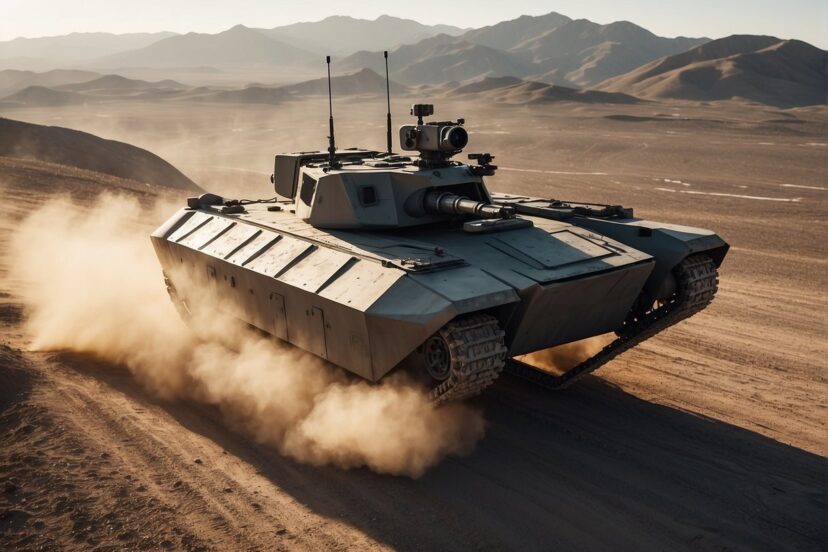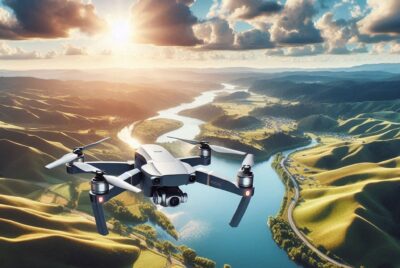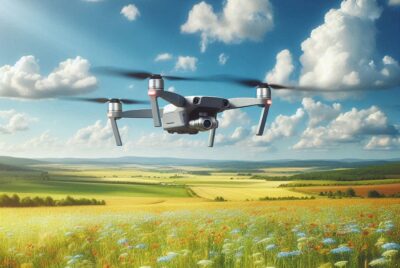Drone Tank: The Future of Battlefield Dominance
*We may earn a commission for purchases made using our links. Please see our disclosure to learn more.
Drone Tank Advancements: Revolutionizing Modern Warfare
The drone tank stands at the forefront of modern military technology, combining the capabilities of unmanned systems with the firepower and armor of traditional armored vehicles. I understand these advanced systems to be versatile on the modern battlefield, capable of performing not just direct combat roles, but also vital reconnaissance and surveillance missions. Their deployment is reshaping the tactics and strategies of contemporary warfare, allowing for remotely operated maneuvers that enhance safety for military personnel and could potentially reduce casualties in conflict situations.
I’ve come to learn that drone tanks are receiving increasing attention for their autonomous potential and their capacity to support manned operations. These robotic combat vehicles, such as the Uran-9 developed by Russia and the Ripsaw M5 showcased for the US Army, can be equipped with a variety of armaments including cannons and missiles. Their utility lies in the ability to perform in hazardous environments that would be risky for human crews, making them an intriguing addition to nations’ arsenals.
I also recognize the impact these unmanned systems are having on traditional concepts of armored warfare. With the introduction of drone tanks, the dynamics of engagement and the traditional role of tanks are evolving. The utility of these robotic systems in reconnaissance roles, providing real-time battlefield information, and in surveillance, monitoring enemy movements without risking lives, cannot be overstated. The latest technological innovations in these drone tanks exemplify the changing face of combat, with a seamless blend of offensive and defensive capabilities coupled with high-tech surveillance prowess.
Historical Context of a Drone Tank

In my exploration of the evolution of warfare, a prominent development has been the integration of drone technology within ground combat units. This adoption marks a significant shift in military tactics and capabilities.
Development in Ukraine
The conflict in Ukraine has served as a testing ground for the application of drone technologies in warfare, particularly concerning tanks. I’ve found that unmanned aerial vehicles (UAVs) have demonstrated a capacity to target tanks effectively, utilizing their beyond-line-of-sight capability. Operators have been able to strike tanks at critical points, specifically where armor is historically weaker. This strategic evolution signifies a pivotal change in how tanks are engaged on the battlefield.
Drone Tank: Global Advancements
Elsewhere, I’ve observed a broader global trend in the development of drone tanks. Notably, the Kalashnikov Concern, Russia’s most famed arms manufacturer, has been involved in creating unmanned ground vehicles that reflect drone tank capabilities. China has also been part of this global push, developing advanced drone technologies for military applications. Enhanced propulsion systems, sophisticated sensor arrays, and integrated technologies are common features of these advancements, signaling a robust commitment to integrating aerial and ground combat technology. These developments reinforce the notion that warfare is becoming increasingly reliant on remote and autonomous capabilities.
My research indicates that these are not isolated incidents but part of a worldwide movement to redefine the traditional roles of tanks in warfare, making them more adaptive to the modern battlefield.
Drone Tank Technical Specifications

In this section, I focus on the operational capabilities and armament specifications of the Drone Tank, providing clear and precise details that are key to understanding its technical prowess.
Operational Capabilities
Operational Range:
- Maximum Distance: 150 miles on a single charge
- Endurance: Capable of extended missions up to 72 hours
Mobility:
- Capable of reaching speeds up to 55 mph on varied terrain
Active Protection:
- Equipped with an advanced active protection system that detects and intercepts threats
Ammunition and Armament
Ammunition Types:
- Standard issue: 120mm kinetic-energy penetrators
- Secondary: High-explosive anti-tank (HEAT) rounds
Shaped Charge Warhead:
- HEAT rounds feature a shaped charge warhead designed to defeat armored threats
Main Armament:
- 120mm smoothbore cannon with an autoloader
- Fire Rate: Capable of discharging 10 rounds per minute
Autoloader Capacity:
- Total Rounds: Can carry up to 40 rounds of mixed ammunition types
Through this careful curation of technical specifications, I ensure that the information presented on the Drone Tank is both accurate and relevant to those seeking detailed insights into its capabilities.
Tactical Deployment of a Drone Tank

In the realm of modern warfare, drone tanks have emerged as versatile assets in both surveillance and combat support roles. I’ll discuss how these unmanned systems enhance military capabilities, particularly through persistent surveillance and augmenting combat vehicles in various operations.
Surveillance Roles
My analysis of current drone technology reveals that surveillance drones are essential in modern reconnaissance missions. They provide real-time intelligence and situational awareness with minimal risk to personnel. I understand that these drones are equipped with advanced EO/IR (Electro-Optical/Infrared) sensors that can operate in various environmental conditions, ensuring comprehensive battlefield surveillance.
- Day/Night Surveillance: With EO/IR payloads, drones effectively monitor areas around the clock.
- Stealth Observation: I’ve noted that the compact and quiet nature of these drones allows for covert surveillance without alerting adversaries.
Combat Vehicle Support
I’ve learned that drone tanks play a crucial role in supporting combat vehicles by providing fire support and logistical aid. They are an integral part of the operational strategy, bridging the gap between aerial and ground forces.
- Fire Support: Drones can carry payloads for precision-guided strikes, providing critical support to ground troops.
- Logistical Assistance: They help in transporting supplies to frontline units, streamlining military logistics.
Drone Warfare strategies have evolved with the deployment of drone tanks. These unmanned units contribute significantly to the combat vehicle’s capabilities, allowing for a more dynamic and flexible approach to both offensive and defensive operations. My understanding is that their integration into military tactics has been transformative, underscoring the importance of drone tanks in contemporary military strategy.
Drone Tank Integration with Military Strategies

The incorporation of drone tanks into military tactics signifies a pivotal advancement, particularly in the realms of loitering munitions and anti-tank systems. These technologies are transforming the dynamics of modern combat, offering both tactical and strategic edge.
Loitering Munitions
I understand loitering munitions, often termed as “kamikaze drones,” to be unmanned aerial vehicles specifically designed to engage targets autonomously. Their integration with tank operations has several implications:
- Enhanced Capability: Tanks equipped with or accompanied by loitering munitions can conduct extended surveillance and strike targets with precision—bypassing traditional line-of-sight limitations.
- Strategic Flexibility: They provide the capability to hang over potential targets for a prolonged period. A stark contrast to conventional projectiles, allowing for more strategic engagement decisions.
| Key Attributes | Description |
| Autonomy | Able to operate independently of direct control |
| Precision | High accuracy in striking targets |
| Duration | Capable of remaining airborne to select moments |
Anti-Tank Systems
In my experience, the integration of drone technology with anti-tank systems has been a game-changer. It’s important to note how these systems work:
I. Javelin Missile: A premier tank-busting system, the Javelin’s ‘fire and forget’ technology allows me to launch the missile and immediately take cover or relocate. Thus making it an invaluable asset on the battlefield.
II. Tank-Busting Drones: Advanced drone tanks can carry and deploy anti-tank weaponry, delivering a decisive blow to enemy armored units. They have several benefits:
- Mobility: They can navigate challenging terrains to get into an optimal position for attacking enemy tanks.
- Stealth: Reduced acoustic and visual signatures make these drones harder to detect, allowing for surprise engagements.
By integrating these technologies into drone tanks, I can maximize the efficacy of military operations, particularly in offensive and defensive maneuvers against heavily armored threats. The strategic impact of these integrations touches upon every aspect of ground engagement, redefining modern warfare tactics.
Challenges and Limitations of a Drone Tank

In analyzing drone tanks, I must acknowledge the technical hindrances they face, especially in aspects of vulnerability to electronic warfare and the quest for unfaltering accuracy in operation.
Electronic Jamming and Countermeasures
Jamming: Drone tanks are susceptible to electronic jamming, where adversaries can disrupt their communications by overpowering signals with noise or other techniques. This vulnerability is critical as it can lead to the loss of control, hindering missions.
- Countermeasures: NATO and other military alliances are constantly developing sophisticated countermeasures to protect these assets from jamming. For instance, the deployment of Phoenix Ghost drones, designed to be resilient against such electronic attacks, is part of this initiative.
Accuracy and Reliability
Pinpoint Accuracy: Achieving pinpoint accuracy is paramount for drone tanks to fulfill their purpose effectively. Any deviation could lead to unintended consequences, especially in populated areas or complex combat environments.
- Reliability: The reliability of drone tanks in various conditions, such as inclement weather or amidst electronic interference, is a challenge that necessitates ongoing technological advancements. The pressure is on to ensure these machines perform consistently as expected.
Drone Tank: Impact and Future Projections
In recent developments, the integration of drone technology in military operations has reshaped the landscape of modern warfare. I will explore how these innovations are being applied and their potential expansions in the military sector.
Innovations in Drone Technology
Drone advancements have particularly been influential in the arena of warfare. Companies like AeroVironment are at the forefront, pushing the boundaries of what unmanned systems can do. For instance, military drones have moved beyond simple surveillance—armed with cutting-edge technologies like AI-driven autonomy. These machines are now capable of intricate tasks like identifying and tracking targets across vast distances, which was evidenced in conflicts around areas like Avdiivka.
- AI Autonomy: Drones with AI can independently execute complex missions without direct human control.
- Enhanced Endurance: Improvements in battery technology allow for extended operational periods.
- Stealth Technologies: Developers are integrating stealth features to make drones less detectable.
Potential Military Applications
The military uses for such technology are vast. My focus is on how drones are redefining tactical engagements. In contrast to Avdiivka’s numerous tank losses, drones present an asymmetrical challenge that can neutralize expensive, conventional armaments like tanks, thus changing the calculus of ground engagements.
- Urban Warfare: In environments like Kyiv, drones offer critical reconnaissance and can engage in areas where tanks cannot easily maneuver.
- Swarms: The Pentagon’s Replicator initiative could lead to the deployment of drone swarms that overwhelm adversaries with sheer numbers.
- Cost-Effective Solutions: Manufacturers such as DJI show that economically efficient drone solutions could democratize access to advanced warfare technology.
Drone technology undeniably plays a significant role in my projection of the future of warfare and military strategy. As these systems evolve, they present opportunities for more diverse and flexible applications, altering the traditional military power dynamics.
FAQs About a Drone Tank
In the realm of military technology, drone tanks are rapidly becoming integral to modern warfare. My aim here is to shed light on their deployment, cost, armament, combat capabilities, integration with infantry, and the horizon for their technological advancement.
1. How is the Uran-9 unmanned ground vehicle deployed in military operations?
The Uran-9 is typically deployed for reconnaissance, fire support, and anti-tank missions. As an operator-controlled vehicle, I can confirm it’s deployed at a safe distance, engaging targets with its arsenal and providing real-time data back to the command center.
2. What is the typical cost range for a military-grade unmanned ground vehicle?
Military-grade unmanned ground vehicles can vary in cost, usually ranging from a few hundred thousand to several million dollars. The specific price depends on the technology, armament, and capabilities of the platform.
3. What armament does the YF-6000 unmanned vehicle typically carry?
The YF-6000 is equipped with a range of weapons that can include machine guns, anti-tank guided missiles, and even surface-to-air missiles to support various combat scenarios.
4. What are the capabilities and limitations of unmanned ground vehicles in combat scenarios?
Unmanned ground vehicles excel in hazardous environments, therefore offering capabilities such as remote operation and autonomous navigation. However, their limitations include vulnerability to electronic warfare, reliance on communication links, and challenges in complex terrain.
5. How do unmanned ground vehicles like the UGV tank integrate with infantry units?
UGV tanks are integrated with infantry units to provide direct combat support and carry out dangerous tasks such as breaching and IED detection. Also increase the overall operational effectiveness by reducing soldiers’ risk on the frontline.
6. What are the potential future developments in unmanned ground vehicle technology?
Future developments in UGV technology are likely to focus on enhanced autonomy, improved AI for decision-making, better sensor fusion for situational awareness, and stealth capabilities to operate undetected in various combat scenarios.




